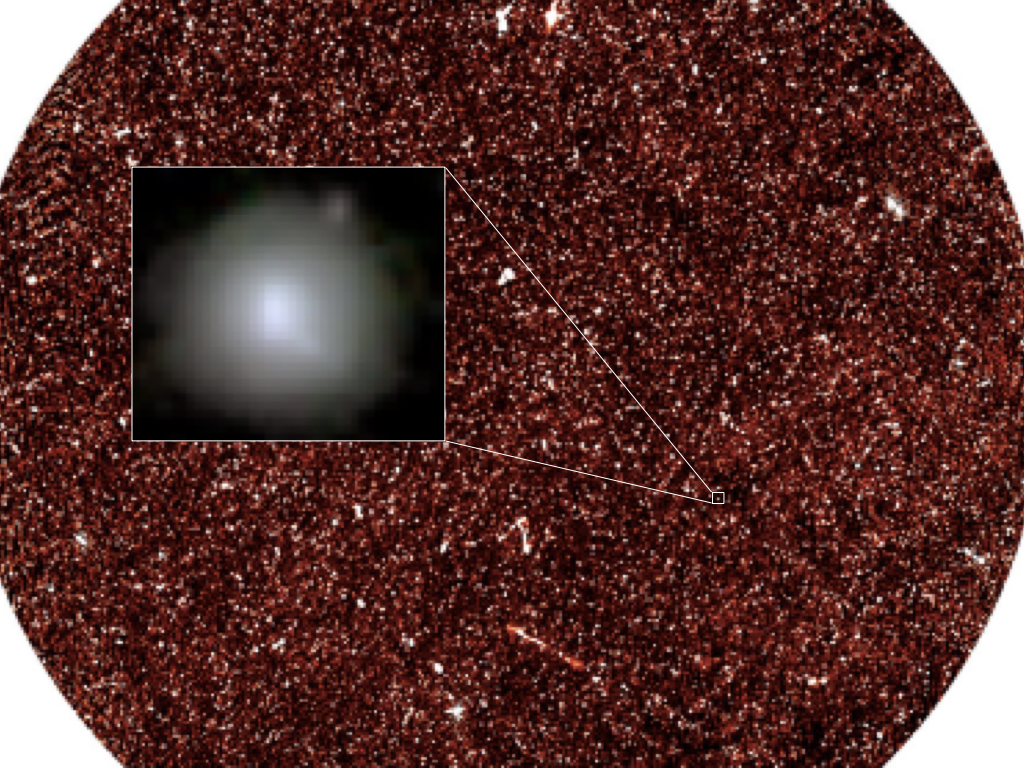Early star-forming galaxies at cosmic noon were engulfed by halos of high-energy cosmic rays
A team of Astronomers led by the Institute for Research in Fundamental Sciences-IPM and including scientists from the Inter-university Institute for Data Intensive Astronomy and University of Oxford has studied a sample of distant galaxies by means of their radio emission observed with the MeerKAT radio telescope- a precursor of the largest radio observatory of the world, the Square Kilometer Array. This allowed for the first time a comparative study of their radio spectrum, magnetic field strength, and star formation rate when the universe was 9-12 billion years younger.

COSMOS field observed with the South African MeerKAT radio array at 1.3 GHz frequency (Heywood et al. 2022). The zoomed box is an artistic illustration of the high-energy cosmic ray halo of a star forming galaxy at cosmic noon.
One of the most pressing questions in astronomy is how galaxies formed and evolved in the universe. To address this question, scientists need information from galaxies billions of light years away. Almost all our information about galaxies comes from their radiating signals, from radio to gamma rays. Observations in visual light show that, after an epoch called cosmic noon (10-11 billion years ago), galaxies start to quench as they form stars at a slower rate over time. However, our understanding of the rate of star formation can be biased when only using visual signals. As radio emission has a longer wavelength and is therefore not affected by interstellar dust, it is the most informative signal from the distant universe. “This motivated us to perform deep radio observations of several fields on the sky with the South African MeerKAT radio telescope, situated 90 km outside the small Northern Cape town of Carnarvon, which is a precursor to the SKA observatory,” says Prof. Russ Taylor, the co-principal investigator of the MeerKAT International GHz Tiered Extragalactic Exploration survey (MIGHTEE).
“Our previous multi-frequency radio observations of nearby galaxies,” says Prof. Fatemeh Tabatabaei from IPM who led this research, “showed that radio signals from 1 to 10 GHz provide a robust tool to measure the star formation rate. The MIGHTEE survey, combined with other radio surveys, allowed us to extend our studies to 160 early galaxies in cosmic noon and beyond.”
“Our detailed analysis shows that the radio spectrum of these galaxies evolves with star formation rate,” says IPM researcher Dr. Maryam Khademi, “which can have important consequences in our understanding of early star-forming galaxies.”
The 1-10 GHz radio emission is mainly due to synchrotron radiation, which is emitted by high-energy electrons (cosmic rays) spiraling along interstellar magnetic fields. Cosmic rays lose their energy more rapidly in stronger magnetic fields as they radiate synchrotron emission. However, the observed spectrum of these early galaxies indicates that these cosmic rays have gained more energy in galaxies with higher star formation rate where the magnetic fields are also stronger. This puzzle can only be solved if cosmic rays gain energy in so-called magnetic mirrors and/or decoupled from the magnetic field through winds and outflows.
“This can occur,” says Prof. Tabatabaei, “if magnetic fields are highly tangled and turbulent in these systems. Turbulent magnetic fields help cosmic rays accelerate to higher energies. These particles then scatter off and decouple from the field”. As such, galaxies at cosmic noon are expected to be engulfed by halos of high-energy cosmic rays. This picture also explains the excess radio emission relative to the infrared emission observed in the sample.
This work is published in the Astrophysical Journal (DOI:10.3847/1538-4357/ade233) and is available at:
https://iopscience.iop.org/article/10.3847/1538-4357/ade233


